699 Search Results for communication book
December 6, 2012
by Robin Parker -
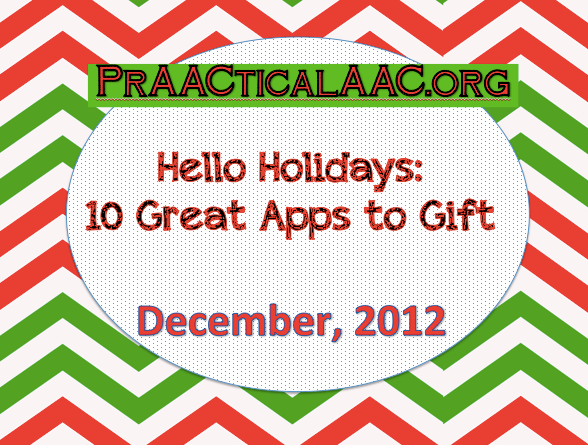
The holidays are prAACtically here and depending upon the holiday traditions you celebrate they may be closer than you realize. Time seems to fly after Thanksgiving and before you know it, social norms seem to dictate gift exchanges, lots of invitations to people’s houses, and of course many gifts for friends and family. An easy way to accomplish gift giving is to ‘gift an app’. You can give apps that are pure fun, educational or a combination of both. To top it off, it is easy to stay within budget, avoid traffic, avoid crowds, and save tons of time (no need to wait for it to arrive). Before you think it’s too complicated, check out these ‘Gifting an App’ instructions by Cult of Mac. The process could not be simpler and you can email the recipient(s) or print out a gift certificate (if necessary right before the gift is needed).... [Read More...]
November 29, 2012
by Carole Zangari -
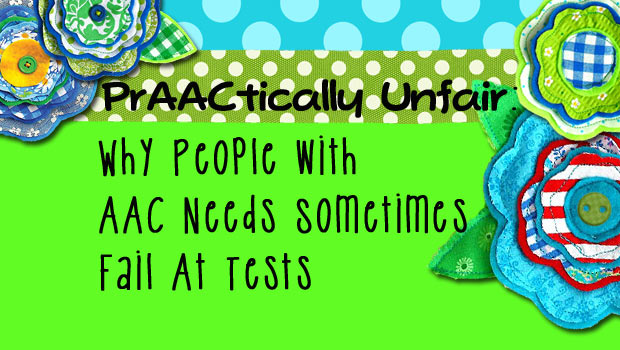
What do these situations have in common? Renting a car with a new GPS system to drive to an interview in a foreign city Hosting a dinner party and cooking a gourmet meal in someone else’s kitchen Using new software to deliver a presentation at a conference If you said they all create anxiety, you’re right. But here’s something else: They all require you to do something unfamiliar or difficult and learn a new tool at the same time and produce results under stressful conditions. We would never put our AAC learners under such stress and expect them to perform well, would we? Of course not! Except when we: Ask them to use an AAC device/app that they are still learning to answer test questions Require them to use a new or exhausting motor pattern to produce a written product for grading Expect students without sufficient test-taking skills to demonstrate... [Read More...]
November 25, 2012
by Carole Zangari -
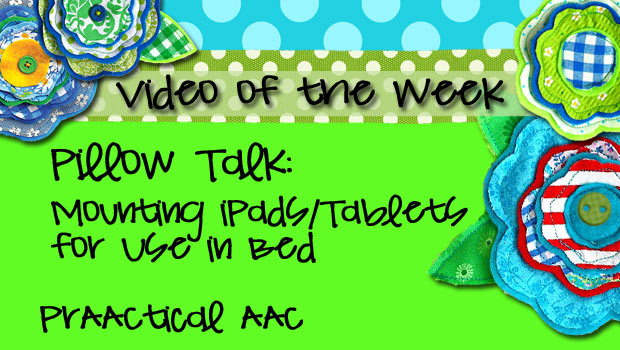
We communicate whenever we’re awake, but sometimes it takes some creativity to find ways to provide AAC access when communicators are not in their main seating systems. It’s always a challenge to figure out mounting strategies so that communication options, whether they are no tech, low tech, or high tech, are always available. This video from the INDATA Project demonstrates an iPad/tablet mount from Charger City that can be used in bed. How cool would it be to use the iPad or Tablet for: Interacting while reading bedtime stories Having a little conversation about the day using the picture schedule app Saying prayers or talking about dreams Watching and listening to some meditation music/images Going over the schedule for the next day Independently reading a book before bed Pleading for ‘just one more’ story, kiss, song, or drink of water We’d love to hear your ideas on other ways to... [Read More...]
November 24, 2012
by Robin Parker -
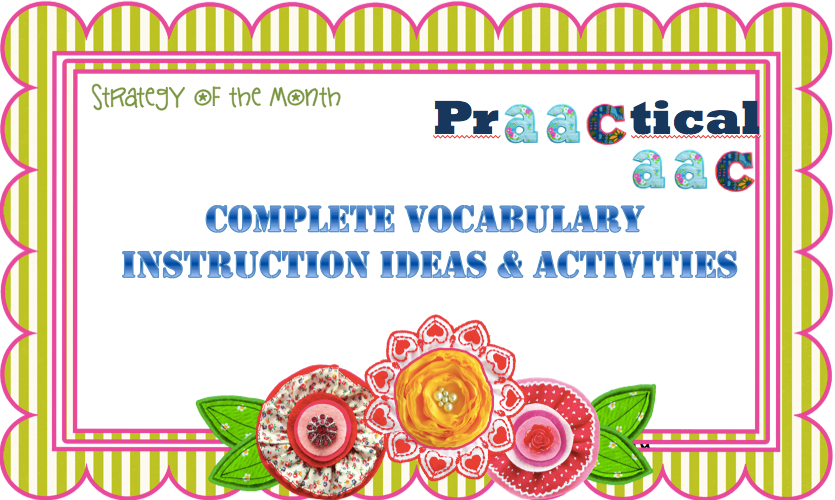
We love incorporating new vocabulary into fun motivating activities even when we are doing direct vocabulary instruction. We embed new vocabulary in activities using all of the language modalities- reading, writing, talking, and listening. We use planned vocabulary instruction activities as well as unexpected opportunities to embed new vocabulary. We like to stay within the theme of vocabulary learning but try and stay flexible in case a perfect opportunity arises that allows us to reflect back on an old vocabulary theme or mention a future planned theme. The main goal of direct vocabulary instruction is more than learning a new list of words, it is learning robust word knowledge so that language skills can be broadened. Consider these vocabulary instruction steps by Robert Marzano. These steps were not specifically developed for AAC users but if we add a language focus and a little more fun and active participation, they... [Read More...]
November 20, 2012
by Robin Parker -
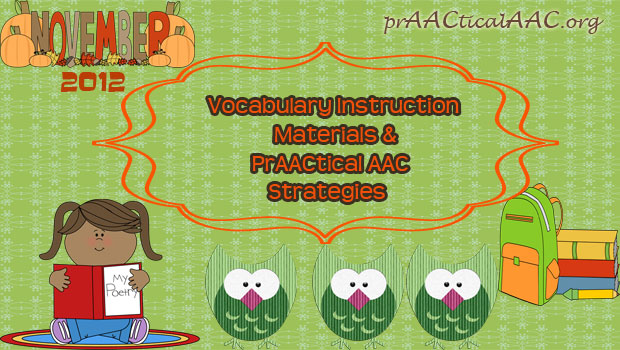
We are super big fans of Teachers Pay Teachers (TPT). We need the PrAACtical resources that TPT offers. In addition to paying ridiculously low prices for some great teaching materials and cool classroom resources, there are also many free options. Check out these free vocabulary resources and have lots of fun. As always, the materials are only as good as the teaching strategies that go with them. As we check out these awesome vocabulary resources, we will use the following guiding principles and we will create appropriate communication opportunities for ALL learners to participate in direct vocabulary instruction. Active Participation for Everyone– Make sure all learners can make choices within the activity, respond to questions, add information, request clarification, and even ask for a break if they need it. To do this we will need one hit message devices, visual supports, individual and group communication displays, choice boards, switches, etc.... [Read More...]
November 14, 2012
by Carole Zangari -
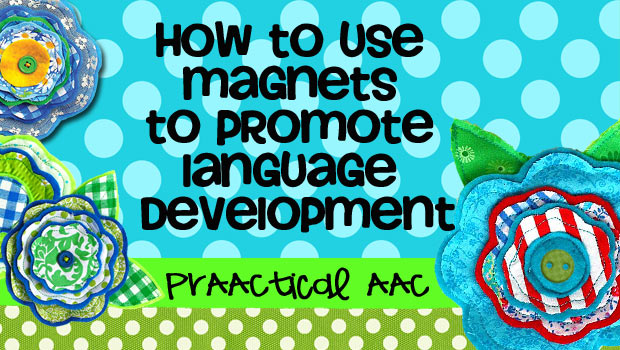
Want to help AAC learners accelerate their receptive vocabularies? Here’s one quick and easy step in the right direction: Talk to them. We’re not trying to be snarky here. The truth is that we speak less to people who are minimally verbal than we do to people who talk. In general, kids with AAC needs hear far less language than speaking children do. Fewer words heard means fewer opportunities to learn language. That’s a cycle worth breaking. When we’re around typically developing children, they’re always asking questions. “What’s in the bag, Mom?” “Why is she doing that?” “How come Billy gets to have one and I don’t?” “Where are we going?” “Are we there yet?” Kids ask lots of questions, particularly in the early years. Annoying? Sometimes. Valuable? Always. From a language learning perspective, those pesky questions serve a very useful purpose: they invite (or demand) a linguistic response. They... [Read More...]
November 10, 2012
by Robin Parker -
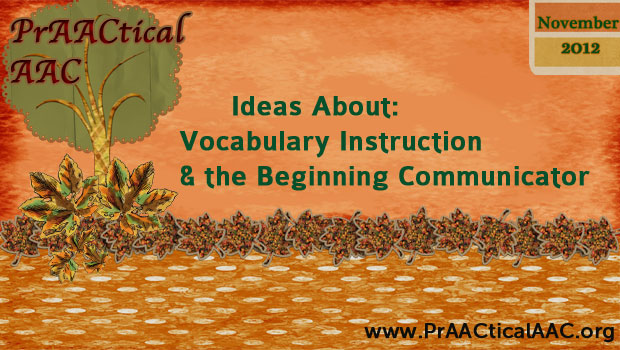
Vocabulary instruction is a topic not often discussed for beginning communicators. As we work with beginning communicators the primary focus is often vocabulary selection for communication displays. This is understandable as the beginning communicator has many needs, but that is no excuse for leaving out vocabulary instruction. Direct vocabulary instruction helps expand broader vocabulary selection options, literacy skills, and world knowledge. With that in mind, see below for vocabulary instruction philosophies, notes, and activities for the beginning communicator. Please let us know about your favorite vocabulary instruction activities. Vocabulary Instruction for the Beginning Communicator: 5 Philosophies Vocabulary instruction involves a systematic TEACHING process. Add vocabulary as an activity on the daily schedule and then have a mini-schedule for the specific vocabulary instruction activities for that day. Carole introduced general steps for vocabulary instruction last week. For the beginning communicator, also apply an errorless learning paradigm. Gradually, add comprehension checks, but... [Read More...]
November 9, 2012
by Carole Zangari -
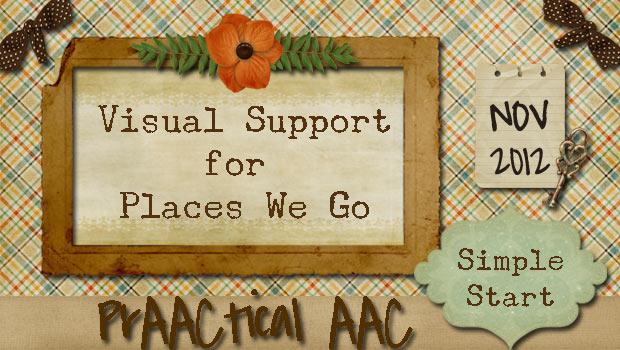
No matter where they work, SLPs supporting people who use AAC generally do what they can to improve communication across environments. In an earlier Simple Start post, we talked about using photos of places within a school to support language comprehension. By showing a picture of the cafeteria or gym as we say those words, we can help both students with language processing difficulties and those with behavior regulation issues. — In this post, we extend the same concept to travels in and around the community. Here are directions for making visual supports that can be used with students who have community-based instruction or by families as they go about their weekly errands and routines. Simple Start: Visual Support for Places in the Community Take photo of locations in the community that the AAC user is likely to visit. Insert them into a document and add labels for each one... [Read More...]
October 25, 2012
by Robin Parker -
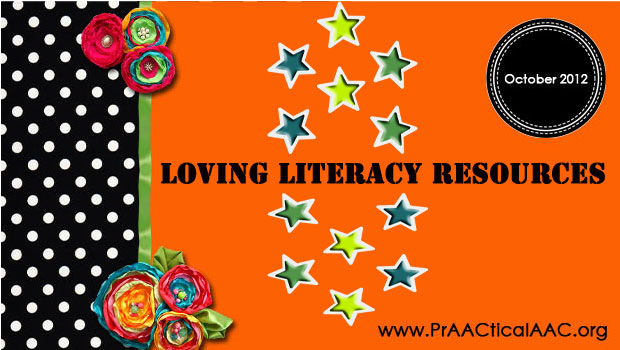
For AAC Awareness Month, we would be remiss if we did not think about literacy. It is a form of communication and language that supports AAC use. Sometimes literacy is difficult for our students, other times it is actually easier and it helps conversational communication and even natural speech. Either way, reading, writing, talking, and listening (understanding) are all modalities of language. There are so many great resource lists for supporting literacy: Jane Farrall’s Letter of the Week: Resources for Older Students, Spectronics Apps for Literacy Support, Melissa Taylor’s 24 Educational iPad Apps for Kids in Reading and Writing, and 25 Great Children’s Apps to Stimulate Literacy, Learning, & Creativity just to name a few. We wanted to share a few additional resources for literacy with general education apps that approach reading through fun with words. And any literacy discussion could not be complete without some seriously great literacy information, theory, and supports... [Read More...]
October 24, 2012
by Carole Zangari -
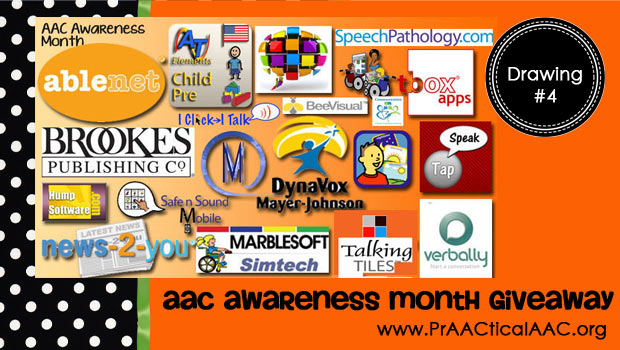
It’s been an exciting AAC Awareness Month! There were 25 lucky winners in the first two drawings and earlier today we drew the names for the third round. The winners for Drawing # 3 are Tanya Keller Scott (#473), Rachel Berry (#266), Carrie Walls (#9), Felicia Moore (#566), Diane Saunders (#34), Jillian Mayo (#164), Juliana Escobar (#425), Amy Vinson Taylor (#138), Allyssa Lucas (#323), Katrina Stebbins (#88), Kristina Frenzel (#480), Jennifer Schroeder (#510), Christine Cobb (#587), Lauren Enders (#53), Mark Neely (#291), Cassie Cann (#213), Amy M (#182), Cassandra Stafford (#366), Monica Venezia (#547), Lizzie Feldman (#579), Melissa Nicole (#364), Erin Finnegan (#434), and Kia Hughes (#383). Congratulations to the winners! Our 4th and final drawing promises to be the best one yet. Please join us in giving virtual round of applause to these generous companies: Ablenet, Inc Abilipad Alexicom Avaz BeeVisual Dynavox/Mayer Johnson Gail Van Tatenhove, PA Hump Software iClick iTalk MarbleSoft Mozzaz News-2-You Patient Provider Communication Paul H. Brookes Publishing Company RJ Cooper Safe N Sound Mobile Say It with Symbols... [Read More...]









